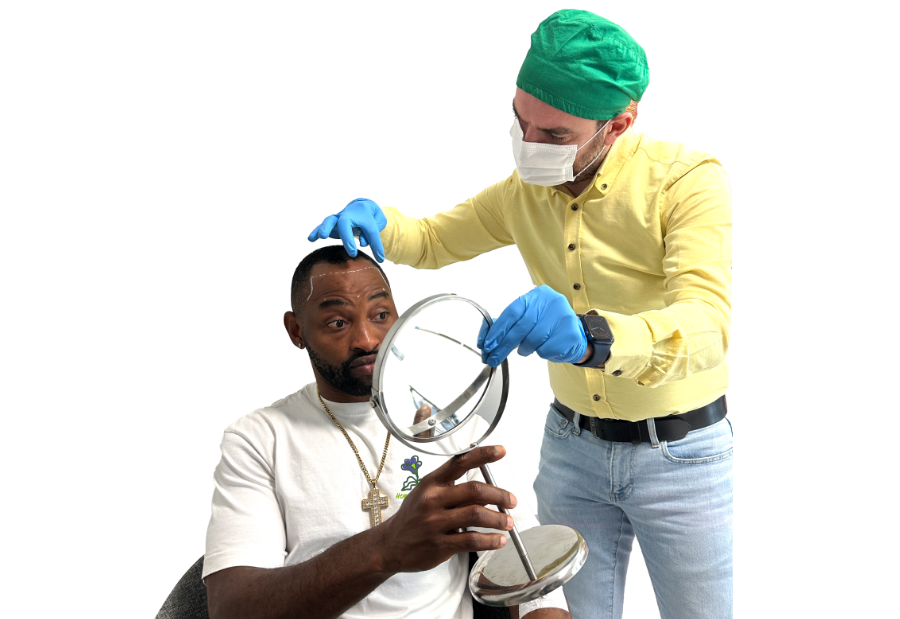Get 25% OFF Hair Transplant Packages This New Year — Book Today!
Common Side Effects of Hair Transplants and How to Manage Them

Introduction
Hair transplants are a proven treatment option for those affected by hair loss. Many people report life-changing results after their procedure, which helped people feel more confident and youthful. There are side effects of hair transplants, just like other medical treatments. Understanding and knowing what to expect as you recover from your hair transplant can help you stay calm, approach your aftercare with confidence, and allow for the best possible outcome. In this blog, we will look at the side effects of hair transplants, how long those side effects usually last, and ways to manage the side effects.
What to Expect After a Hair Transplant
Is It Normal to Experience Side Effects?
It is completely normal to face some discomfort or minor issues after a hair transplant. These are generally temporary and a natural part of the healing process. The body responds to any surgical procedure, even a minimally invasive one like hair restoration, by showing signs like redness, swelling, or slight irritation. Understanding the side effects of hair transplant surgery makes it easier to handle the process with confidence.
Temporary vs. Long-Term Reactions
Most side effects of hair transplant only last a few days to a couple of weeks. These include swelling, itching, and scabbing. In rare cases, patients may experience longer-term effects like numbness or folliculitis, but these are usually mild and manageable. Knowing the difference between short-term reactions and rare complications can help you decide when to let it pass and when to talk to your doctor.
Before making a decision, it’s important to understand the common myths about hair transplant surgery that often mislead patients
Most Common Side Effects of Hair Transplant
Swelling of the Scalp and Forehead
One of the most common issues is scalp swelling after transplant. This usually appears within the first few days. It can spread from the top of your head to your forehead or even around the eyes. While it can be alarming to see swelling after your hair transplant, it is typically not a cause for concern and will resolve itself in a few days. Cold compresses on your forehead and sleeping with your head elevated will help reduce your swelling.
Itching and Scalp Irritation
Mild itching is a normal part of the healing process after a hair transplant. As your skin heals, it may dry out or flake, which can lead to mild itchiness. Do not scratch and risk damaging or displacing your grafts; instead, use a mild approved moisturizing spray or ask your clinic for recommendations on lotion to soothe the itch.
Scabbing and Crusting Around the Grafts
The first week after your hair transplant, you may develop tiny scabs around the implanted follicles. This is normal, as it is part of the natural healing cycle. The important note is to avoid picking at the scabs. Allowing your scabs to fall off naturally, you minimize the risk of infection and allow your grafts to stay put.
Temporary Hair Shedding (Shock Loss)
A hair transplant is almost always followed by a period of “shock loss.” Your transplanted hair and the natural hair around the grafts will fall out. This generally happens anywhere from two to four weeks after having the procedure. While it may look alarming, it is a temporary state of hair loss, and new growth should begin shortly thereafter. Knowing that this is a normal part of the process will help to alleviate any concerns you may have.
Numbness or Tingling Sensation
Some patients experience numbness or tingling in the donor or recipient area. This happens because tiny nerves may get disturbed during surgery. These sensations typically resolve within a few weeks or months. It’s not painful but can feel strange at first.
Infection and Folliculitis (Rare)
Infections after hair transplants are rare, especially if proper hygiene is followed. However, symptoms like severe redness, pus, or fever should not be ignored. Another rare condition is folliculitis, which is an inflammation of the hair follicles. It looks like small red bumps or pimples. Your surgeon may prescribe medication or topical creams to treat it.
How to Manage and Minimize Side Effects of Hair Transplant
Proper Post-Operative Care and Hygiene
Cleanliness is crucial after a hair transplant. Use only the recommended shampoo and avoid direct water pressure on the scalp. Pat dry gently with a soft towel. Good hygiene lowers the chances of infection and supports faster healing along your hair transplant healing timeline.
Using Medications as Prescribed
Medication after a hair transplant can include antibiotics, anti-inflammatory tablets, or pain relievers. These are given to prevent infection and reduce discomfort. It’s important to follow your surgeon’s dosage instructions and not skip any medications, even if symptoms seem to improve quickly.
How to Sleep and Avoid Pressure on Grafts
Sleeping with your head elevated for at least three to four nights helps reduce swelling. Avoid sleeping on your stomach or sides, as this puts pressure on the grafts. You can use travel pillows or rolled towels to keep your head steady. This is one of the best ways to recover after a hair transplant and protect new follicles.
When to Seek Medical Attention
If you experience intense pain, unusual swelling, persistent bleeding, or signs of infection, reach out to your clinic immediately. While most side effects are minor, timely treatment prevents complications. Never try to treat serious symptoms at home without guidance from your surgeon.
Tips for a Smooth Recovery After a Hair Transplant
Follow Your Surgeon’s Instructions Closely
Every clinic provides a set of aftercare instructions tailored to your procedure. Follow them closely. They include how to clean the scalp, what to avoid, and when to return for checkups. Listening to expert advice ensures smoother healing and better long-term results.
Avoid Physical Activity and Heat Exposure
Intense workouts, heavy lifting, or anything that makes you sweat heavily should be avoided for at least 10 to 14 days. Heat and sweat can irritate the scalp or affect graft survival. Also, avoid saunas, hot showers, and direct sun for a few weeks, as these can delay recovery.
Be Patient: Healing Takes Time
It’s natural to feel eager to see results, but hair transplant healing timelines are different for everyone. Visible changes usually start around the third or fourth month, with full growth seen in 9 to 12 months. Stay patient and trust the process. Rushing or being careless can undo the hard work done during surgery.
For effective post hair transplant care and recovery, follow these essential recovery tips after a hair transplant to ensure faster healing and optimal results.
Conclusion: Managing Side Effects for Better Results
Understanding the side effects of hair transplants helps you feel more confident and in control throughout your recovery. Most symptoms are mild and temporary. With proper care, hygiene, and follow-up, they can be managed easily. Following your surgeon’s advice, using the right medication after a hair transplant, and giving your body time to heal are key to achieving the best outcome. If you’re prepared, informed, and patient, you’ll be well on your way to enjoying healthy, permanent hair growth.

